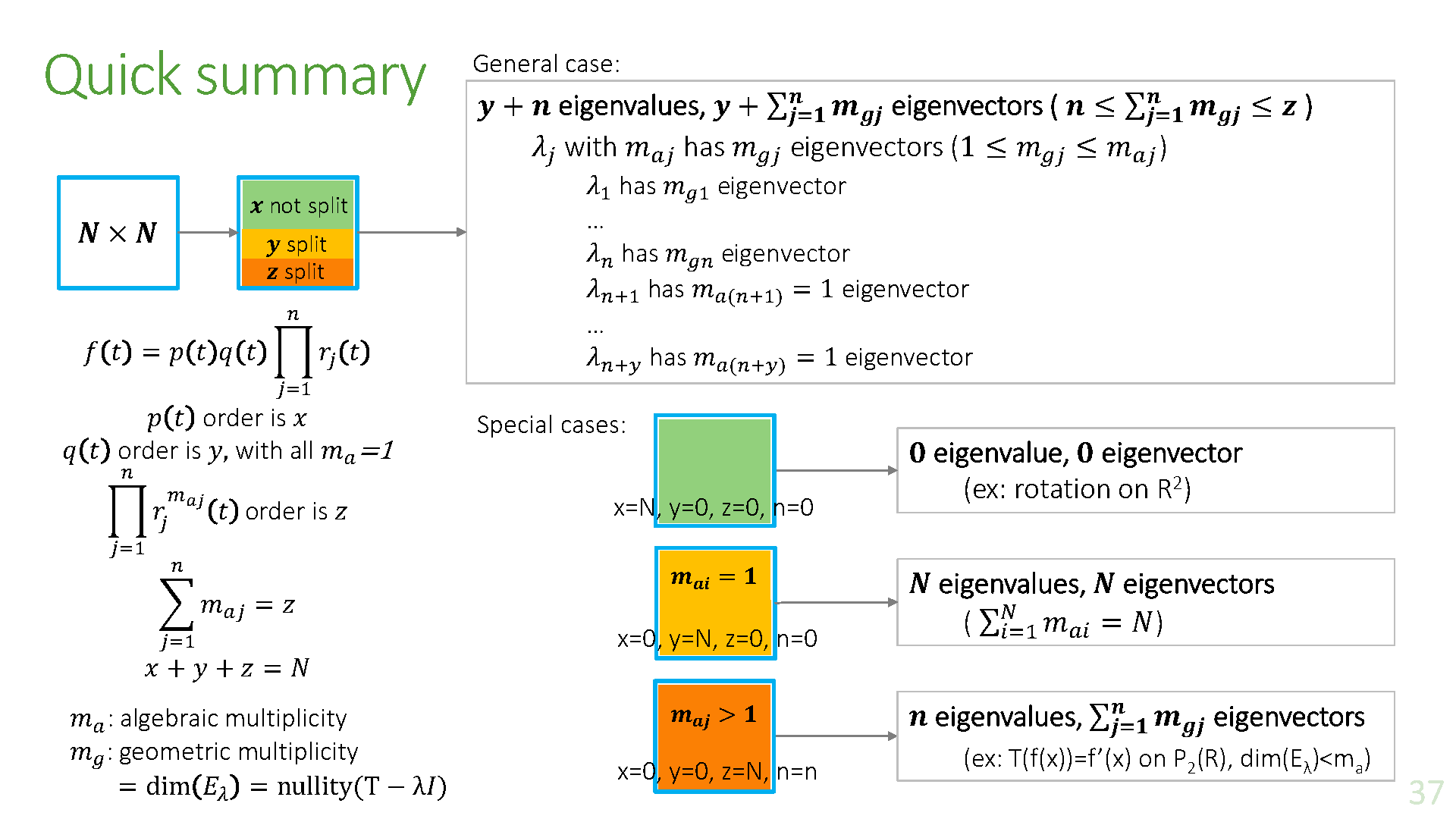5 Eigenvalues and Eigenvectors
5.1 Eigenvalues and Eigenvectors
Definition and Theorem
This chapter is concerned with the so-called diagonalization problem. For a given linear operator
- Does there exist an ordered basis
for such that is a diagonal matrix? - If such a basis exists, how can it be found?
Definitions: diagonalizable
A linear operator
Definitions: eigenvalue & eigenvector
Let
Let
Theorem 5.1
A linear operator
Furthermore, if
Corollary
A matrix
Example 5.1.1
Let
Since
and so
then
Example 5.1.2
Let
It is clear geometrically that for any nonzero vector
While in the field of complex number
For basis
Let
Then
Example 5.1.3
Let
Let
Suppose
(Here, the function
Theorem 5.2
Let
Definition: characteristic polynomial (For matrix)
The polynomial
Definition: characteristic polynomial (For linear transformation)
Let
Example 5.1.4
To find the eigenvalues of
we compute its characteristic polynomial:
Hence, the only eigenvalues of
Example 5.1.5
Let
let
(Explanation:
)
The characteristic polynomial of
Hence
Theorem 5.3
Let
- The characteristic polynomial of
is a polynomial of degree with leading coefficient . has at most distinct eigenvalues.
Theorem 5.4
Let
Example 5.1.6 [core]
To find all eigenvectors of the matrix
recall
A vector
Clearly the set of all solutions to this equation is
Now, suppose
Hence
Thus
Observe that
is a basis for
Suppose that
The diagonal entries of this matrix are the eigenvalues of
To find the eigenvectors of a linear operator
Now
An equivalent formulation of the result discussed in the preceding paragraph is that for an eigenvalue
We can choose to solve the problem using whichever path is easier.
Example 5.1.7
Let
We consider each eigenvalue separately. Let
Then
is an eigenvector corresponding to
Notice that this system has three unknowns,
for
for any
Next let
It is easily verified that
and hence the eigenvectors of
for
Since
the eigenvectors of
for
For each eigenvalue, select the corresponding eigenvector with
5.2 Diagonalizability
Theorem 5.5 and Corollary
What is still needed is a simple test to determine whether an operator or a matrix can be diagonalized, as well as a method for actually finding a basis of eigenvectors.
Theorem 5.5
Let
Corollary
Let
Example 5.2.1
Let
The characteristic polynomial of
split
Definition: split over
A polynomial
For example,
If
Theorem 5.6
The characteristic polynomial of any diagonalizable linear operator splits.
From this theorem, it is clear that if
The converse of Theorem 5.6 is false; that is, the characteristic polynomial of
Definition: multiplicity
Let
Example 5.2.2
Let
which has characteristic polynomial
Remark
Let
The multiplicity of
The dimension of the eigenspace associated to eigenvalue
where
Therefore we have
The eigenvectors of
eigenspace
Definition: eigenspace
Let
Theorem 5.7
Let
where
Example 5.2.3
Let
Consequently, the characteristic polynomial of
Thus
A matrix is diagonalizable if and only if the algebraic multiplicity and geometric multiplicity are equal for all eigenvalues.
Example 5.2.4
Let
We determine the eigenspace of
and hence the characteristic polynomial of
So the eigenvalues of
Since
which means
Similarly,
Since the unknown
So a basis for
In this case, the multiplicity of each eigenvalue
is linearly independent and hence is a basis for

Lemma
Let
then
Theorem 5.5 says that eigenvectors which corresponds to different eigenvalues are linearly independent, so the only possibility is that they are all zeros.
Theorem 5.8
Let
Theorem 5.9
Let
is diagonalizable if and only if the algebraic multiplicity of equals for all (i.e. algebraic multiplicity = geometric multiplicity). - If
is diagonalizable and is an ordered basis for for each , then
is an ordered basis for
Test for Diagonalizability
Let
- The characteristic polynomial of
splits. - For each eigenvalue
of , the multiplicity of equals the corresponding geometrical multiplicity:
Example 5.2.5
We test the matrix
for diagonalizability.
The characteristic polynomial of
which splits and so condition 1 of the test for diagonalization is satisfied. The eigenvalues are
Since
the matrix
Example 5.2.6 [core]
Let
With
The characteristic polynomial of
which splits. Hence, condition 1 of the test for diagonalizability is satisfied.
Also,
Condition 2 is satisfied for
Checking condition 2 for
the rank of
We now find an ordered basis
- The eigenspace corresponding to
is
which is the solution space for the system
and has
as a basis.
- The eigenspace corresponding to
is
which is the solution space for the system
and has
as a basis.
Let
Then
Finally, observe that the vector in
which is an ordered basis for
Example 5.2.7
Let
We show
First observe the characteristic polynomial of
By applying the corollary to Theorem 5.5 to the operator
are bases for the eigenspaces
is an ordered basis for
be the matrix whose columns are the vectors in
To compute
Systems of Differential Equations
Exercise 5.2.8
Consider the system of differential equations
where each
Let
and
Let
be the coefficient omatrix of the given system, so that we can rewrite the system as matrix equation
It can be verified that for
we have
or equivalently,
Define
which is a system of decoupled equations
Solutions for each
with arbitrary constants
Back-substituting,
Thus the general solution is
where
This concludes the main part of the example.
Here is more generalized conclusion.
Application for ODE
Let
Suppose
Prove that a differentiable function
where
Following the step of the previous exercise, we may pick a matrix
For the second statement, we should know first that the set
are linearly independent in the space of real functions. Since
is an